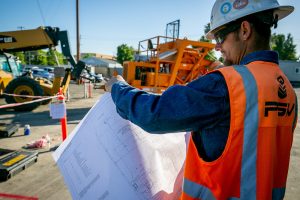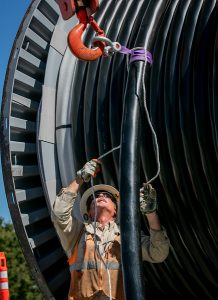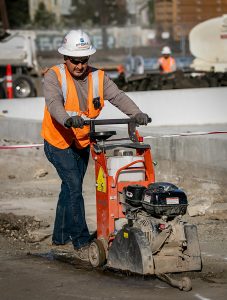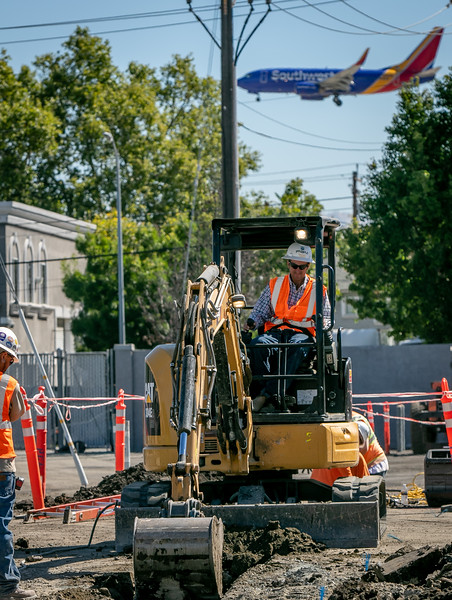IBEW 1245 outside construction crews are hard at work on the preliminary development of Caltrain’s 50-mile rail electrification project from San Francisco to San Jose. The project, which broke ground last year, is providing ample work for dozens of IBEW members, who will continue on through the various phases of the job until the electrified trains are up and running, which is slated to occur in 2021.

IBEW 1245 member Kyle Jones of PGM looks over the plans
Caltrain plans to replace around 75% of its current diesel trains with electric trains, which will be cleaner, greener quieter, and more reliable —and with significantly more capacity to boot. According to Caltrain, the new electric trains will be able to accommodate 80 percent more passenger trips per day, removing 619,000 cars from the Bay Area’s congested daily commute, while simultaneously reducing CO2 emissions by 176 metric tons per year.
This electrified rail line will eventually be “blended” into California’s highly anticipated high-speed rail system, upon which travelers will be able to get from Los Angeles to San Francisco by train in under three hours. That system is scheduled to come online around 2029.
Building a New Substation
A large part of the preliminary phase of the electrification involves the construction of a new substation, to take the place of the existing FMC substation located near San Jose’s Mineta Airport. Transitioning to a whole new substation requires a lot of work, and much of the infrastructure being constructed in this early phase will be torn out and replaced in a couple years – but the project could not proceed without this initial groundwork, which will allow for the transition to take place.

IBEW 1245 member Bob Hawk of Dacon guides the cable
IBEW member Robert Brock, a general foreman with Dacon Corporation, has been working on the electrification project in San Jose for several months. When the Utility Reporter caught up with Brock and his crew, they were laying high voltage underground cables at the FMC sub, in order to facilitate the construction of the new substation on the far side of the freeway.
“Right now we’re pulling in 115kv underground cable; we’re pulling in a phase a day,” said Brock. “We pulled one phase yesterday, we’re doing B phase today, and hopefully if everything goes right we’ll pull in C phase tomorrow.”
Maneuvering the large, heavy cable is no easy feat. Brock notes that the cable weighs 23.5 pounds per foot, with an outside diameter of five inches. The crews had to use electric cable rollers to pull the cable, which is carefully controlled from the reels so that it rolls off smoothly. According to Brock, the biggest challenge is keeping enough slack at all times—as the cables come off, the reel becomes lighter and lighter, requiring steady and careful attention. Brock expects this phase of the project to be complete in the next few months.

IBEW 1245 member Miguel Quinones of PGM digs a ditch for pipes that will eventually contain fiber-optics
Meanwhile, IBEW member Jim Burrow and his colleagues from PGM are also hard at work at the FMC substation, laying pipe which will eventually be used for ultra-high-tech fiber-optics.
“We’ve got one crew digging the ditch, four feet deep, and another crew is putting four inches of sand under the four-inch pipe,” Burrow explained. “Then we’ll get it inspected and wet it down, and then we’re going to throw 12 inches of sand on top of the pipe – so if anyone digs in, they’ll see the sand and stop digging.”
After this phase of the project is complete in the next couple of weeks, Burrow plans to come back in a few months for the next phase of the project.
Burrow, an 18-year member of IBEW 180 in the North Bay, is grateful for the wages, protections and job security he is afforded through the union.
“They’ve always got my back,” he says of the IBEW. “The pay is right. And I’ve always got work.”
As an IBEW member for 50 years who hails from Texas, Brock also values everything that the union has provided him over his long career — particularly after an off-the-job motorcycle accident left him partially disabled.
“I could sit here all day talking about how good the union has been to me,” he told the Utility Reporter. “I had an accident 13 years ago and lost this left leg. The union and my company both took care of me, I’m still working.”
Photos by John Storey

Bob Hawk guides the cable

Justin Jones

Jorge Uribe

Carlos Lawson

Miguel Quinones digs a ditch for pipes that will eventually contain fiber-optics

Jonathan Perez

Pulling cable

Tom Stansberry

IBEW 1245 member Kyle Jones of PGM looks over the plans